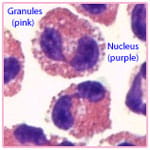Eosinophils are Specialized Immune Cells
The eosinophil is a specialized cell of the immune system. This proinflammatory white blood cell generally has a nucleus with two lobes (bilobed) and cytoplasm filled with approximately 200 large granules containing enzymes and proteins with different (known and unknown) functions.


The white blood cells shown above are stained with hematoxylin and eosin (H&E). H&E staining is a common method used in histology. The hematoxylin stains the nuclei of cells (purple), the control center of the cell where the DNA is located. The eosin stains proteins (pink). The white blood cells shown here (left panel) are eosinophils (nucleus with 2 lobes) and neutrophils (nucleus with 2-5 lobes). The intense pink staining in the eosinophils is the reason why these cells were named "eosinophils", meaning "eosin loving".
In the high-magnification H&E staining of blood eosinophils above (right panel), the bright pink marks the mediator- and protein-stuffed granules that break open when the eosinophil is activated. The granule contents are toxic to both invaders and a person's own cells and tissues.
Maturation process
Eosinophils are formed exclusively in the bone marrow where they spend about 8 days in the process of maturation before moving into the blood vessels. They travel through the vessels for 8 to 12 hours before they finally arrive at destination tissues, where they remain for 1 to 2 weeks. Interleukin 5 (IL-5) appears to be the major growth factor for this type of cell.
Many diverse functions
The functions of the eosinophil are varied, some of which are very similar to other white blood cells. They are implicated in numerous inflammatory processes, especially allergic disorders. In addition, eosinophils may have a physiological role in organ formation (e. g. postgestational mammary gland development).
Eosinophilic functions include: movement to inflamed areas, trapping substances, killing cells, anti-parasitic and bactericidal activity, participating in immediate allergic reactions, and modulating inflammatory responses.
Can be either helpful or harmful
At one extreme, such as in the illness erythema toxicum, eosinophils play the role of a beneficial modulatory element or an innocent bystander. At the other extreme, represented by conditions like Loeffler's disease and idiopathic hypereosinophilic syndrome, eosinophils are linked with permanent pathologic changes.
More Information
Treatment: The primary treatments for eosinophilic disorders, such as eosinophilic gastrointestinal disorders (EGIDs) and hypereosinophilic syndrome (HES), are medications and dietary therapy. Learn more.
Research: Our research involves basic, clinical and translational studies to determine the reason for the current epidemic of eosinophilic disorders and to develop diagnostics and a cure for these conditions. Learn more.
Donate: We truly appreciate the generous funding and donations supporting our research to improve patient outcomes at the Cincinnati Center for Eosinophilic Disorders. Donate today.



